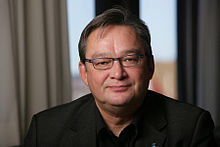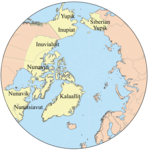Greenlandic Inuit
| Total population | |
|---|---|
| c. 70,000 | |
| Regions with significant populations | |
| Greenland | 51,349 Tunumiit )
|
| Related ethnic groups | |
| other Inuit people | |

The Greenlandic Inuit (Greenlandic: kalaallit, Danish: Grønlandsk Inuit) are the indigenous and most populous ethnic group in Greenland.[12] Most speak Greenlandic (Western Greenlandic, Kalaallisut) and consider themselves ethnically Greenlandic. People of Greenland are citizens of Denmark.
Approximately 89 percent of Greenland's population of 57,695 is Greenlandic
- the Kalaallit of west Greenland, who speak Kalaallisut
- the Tunumiit oraasiat("East Greenlandic")
- the Inughuit of north Greenland, who speak Inuktun ("Polar Eskimo")
Historically,
Today, most Greenlanders are bilingual speakers of
Regions
The Inuit are descended from the Thule people, who settled Greenland in between AD 1200 and 1400. As 84 percent of Greenland's land mass is covered by the Greenland ice sheet, Inuit people live in three regions: Polar, Eastern, and Western. In the 1850s, additional Canadian Inuit joined the Polar Inuit communities.[14]
The Eastern Inuit, or Tunumiit, live in the area with the mildest climate, a territory called Tunu or Tasiilaq. Hunters can hunt marine mammals from kayaks throughout the year.[14]
Language


History

The first people arrived in Greenland from the Canadian island of
The primary method of survival for the Thule was hunting seal, narwhal, and walrus as well as gathering local plant material.[17][19][18] Archaeological evidence of animal remains suggests that the Thule were well adjusted to Greenland and in such a way that they could afford to leave potential sources of fat behind.[19]
European visitors to Northeast Greenland before the early 19th century reported evidence of extensive Inuit settlement in the region although they encountered no humans. In 1823,
In 1979, the Greenlanders voted to become autonomous. There is an active independence movement.
The population of Greenlandic Inuit has fluctuated over the years. A smallpox outbreak reduced the population from 8,000 to 6,000 in the 18th century.[20] The population doubled in 1900 to 12,000 then steadily rose by around 100 people each year from 1883–1919.[20] Tuberculosis caused a drop in the population, but after several decades of steady birth rates and commercial fishing over traditional hunting, the population reached 41,000 in 1980.[20]
Society
Gender roles among Greenlandic Inuit are flexible; however, historically men hunted and women prepared the meat and skins. Most marriages are by choice, as opposed to arranged, and monogamy is commonplace. Extended families are important to Inuit society.
Greenland Inuit diet consists of a combination of local or traditional dishes and imported foods, with the majority of Inuit, aged 18 to 25 and 60 and older, preferring customary, local foods like whale skin and dried cod over imported foods like sausage or chicken.[21] That study also reveals that those who grew up in villages only consumed local, Inuit cuisine foods 31 times a month and those who lived in Danish areas would consume local, Inuit cuisine 17 times per month.[21] The reasons for the lack of traditional food consumption varies, but 48 percent of respondents claim that they wanted to have variety in their diet, 45 percent of respondents said it was difficult to obtain traditional foods, and 39 percent said that traditional foods were too expensive.[21]
The kinds of whale that have been historically hunted and consumed are the Minke and Fin whales, both are under watch by the International Whaling Commission (IWC).[22][23] Greenland Home Rule implemented IWC quotas on aboriginal whale hunting, reducing hunting of Minke whales to a maximum of 115 per year and Fin whales to 21 per year.[22]
Art and religion
The Greenlandic Inuit have a strong artistic practice based on sewing animal skins (
Customary art-making practices thrive in Ammassalik Island.[25] Ammassalik wooden maps are carved maps of the Greenlandic coastline, used in the late 19th century.
Greenlandic Inuit believed that spirits inhabited every human joint, even knucklebones.[26]
See also
Notes
- ^ "Grønlands Statistik". Stat.gl. Retrieved 2015-10-25.
- ^ "Statistikbanken". Statistics Denmark. 2018. Retrieved July 22, 2018.
- ^ "Table 1. First, Second, and Total Responses to the Ancestry Question by Detailed Ancestry Code: 2000". U.S. Census Bureau. Retrieved 2013-05-05.
- ^ "Foreign born, by sex and country background". Statistisk centralbyrå - Statistics Norway. Retrieved 2016-07-03.[permanent dead link]
- ^ "IB01040 Population by birth country, sex and age, 1th January (1985-2016)". Hagstova Føroya - Statistics Faroe Islands. Retrieved 2016-07-03.
- ^ "Population by country of birth, sex and age 1 January 1998-2015". Hagstofa Íslands - Statistics Iceland. Retrieved 2016-07-03.
- ^ "Immigrant population by place of birth, period of immigration, 2016 counts, both sexes, age (total), Canada, 2016 Census". Statistics Canada. 2017-10-25. Retrieved 2018-07-22.
- ^ "Population; sex, age, migration background and generation, 1 January". Statistics Netherlands (CBS). Retrieved 2018-07-22.
- ^ a b c d "Greenland." Archived 2020-05-09 at the Wayback Machine CIA World Factbook. Retrieved 6 Aug 2012.
- ^ a b "Inuktitut, Greenlandic." Ethnologue. Retrieved 6 Aug 2012.
- ^ Lawrence C. Hamilton and Rasmus Ole Rasmussen, "Population, Sex Ratios and Development in Greenland", Arctic 63, no. 1 (2010): 43–52.
- ^ "The Indigenous World 2023: Kalaallit Nunaat (Greenland)". 24 March 2023. Retrieved 28 March 2024. at the International Work Group for Indigenous Affairs
- ISBN 978-0-08-044656-1.
- ^ a b Hessel 11
- ^ PMID 21628586.
- PMID 21628586.
- ^ S2CID 7773726.
- ^ S2CID 162882708.
- ^ JSTOR 40316508.

- ^ JSTOR 40513368.
- ^ JSTOR 40512274.
- ^ S2CID 53512929.
- ^ "Population Estimates". iwc.int. Retrieved 2018-03-17.
- ^ Hessel 21
- ^ Ingo 20
- ^ Subin, Anna Della. "The enchanted worlds of Marshall Sahlins".
References
- Hessel, Ingo (2006). Arctic Spirit. Vancouver: Douglas and McIntyre. ISBN 978-1-55365-189-5.
External links
- Inuit Circumpolar Council: Greenland
- Culture and History of Greenland, Greenland Guide
- Colonialism in Greenland: An Inuit Perspective Archived 2017-10-31 at the Wayback Machine



